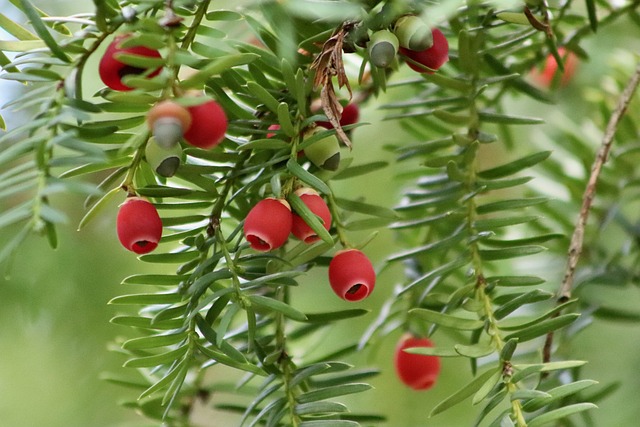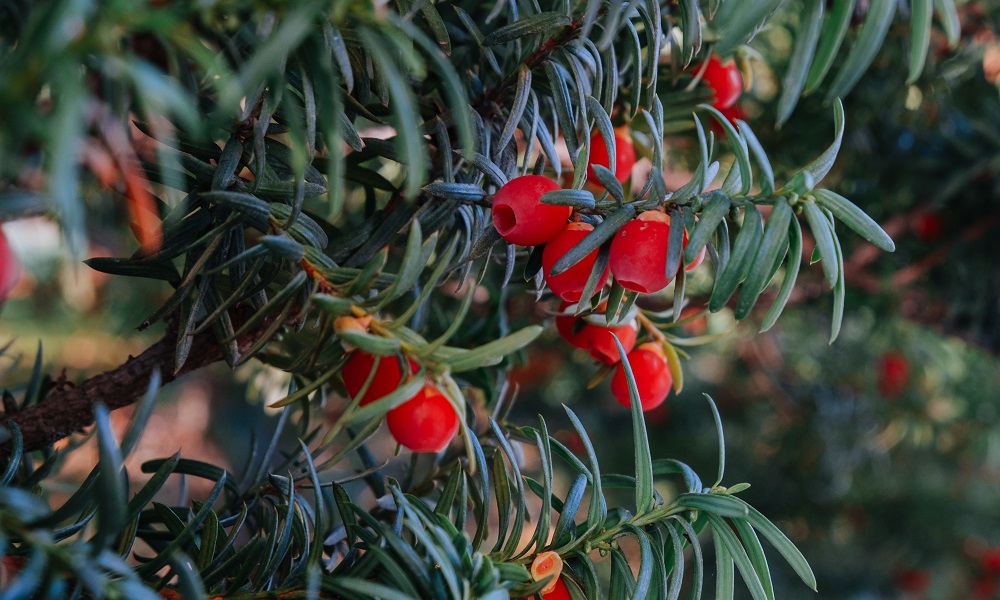Log in or create new account to save this product to your wishlist.

Yew Pruning Guide: Tips for Shaping Yew Hedges
Yew trees are slow- and dense-growing but offer excellent all-round privacy and beautiful in your outdoor spaces. Find out how to prune for perfection!
🌱 All important maintenance moments for your lawn during the year. Leave your email and we will send you the lawn calendar for free.
Enter your email
Receive the lawn calendar in the mail
Enjoy a green lawn all year round!

- Order by 2PM = shipped today
- 250.000+ satisfied customers!
- 60 day satisfaction guarantee
Yew — loved by many but considered too demanding by some. However, these dense green plants are ideal for garden coverage, offering texture, colour, and privacy. And with a bit of know-how, you’ll master yew pruning so that you can admire this stunning green plant in your garden.
- Do I need to prune my yew?
- Pruning your yew for sunlight
- Yew pruning — which time of year is best?
- Which tool should I use for yew pruning?
- WARNING! Yew is poisonous!
- How to prune yew
- Yew pruning — essential aftercare
- Dispose of green waste correctly!
- The mistakes to avoid when yew pruning
- FAQs
And while pruning yew isn’t difficult, you need to know what you’re doing for the best results.
Which is why I’ve put together this comprehensive guide. Learn which mistakes to avoid when yew pruning and how to get the most out of your stunning all-year plant.
Ready? Let’s go!
Do I need to prune my yew?

A yew tree is a beautiful addition to any garden. Its dense growth brings an elegant touch to your outdoor space, but proper yew cutting is the key to maintaining the shape and appearance. And although the yew is a slow grower, you can expect 20-40cm of growth each year.
This means that yew offers several possibilities because of its relatively low maintenance needs, from solitary plants in tree form to pruned hedges or individual shrubs. And regular pruning is the best way to maintain the desired shape and size.
But it can be tempting to let a yew tree grow wild. And while that option still offers an attractive plant, yew trees are susceptible to diseases and pests. So, pruning your yew helps keep the focus on healthy growth, which maintains the plant’s resistance.
Pruning your yew for sunlight
One of the most significant problems with yews is their dense growth. And this can fairly rapidly block sunlight and drain the soil’s nutrients, leaving nearby plants bereft of nourishment.
So, by regularly pruning your yew, you can control the density and height — creating a more harmonious environment for all your garden’s plants.
Additionally, yew trees live for a long time. However, over time, the foliage becomes thin and more difficult to shape. So, yew pruning throughout its earlier life stimulates growth and helps the plant maintain its vitality for longer.
Yew pruning — which time of year is best?
The best time of year to prune your yew is late spring or early summer (late May to early July). This is when the yew is actively growing, which will recover more quickly, preventing diseases and pests from settling into the cuts.
The general rule is to prevent heavy pruning after August 15th! This is because pruning stimulates new growth, which may not harden off before the colder weather and the chances of frost during autumn.
However, if you absolutely must prune later in the year, wait until the plant reaches dormancy during the winter when the plant is growing more slowly. But avoid periods of frost, as this can damage the plant if it has exposed wood.
Which tool should I use for yew pruning?
The tool you choose for pruning your yew depends on the size and condition of the plant.
For smaller branches, use pruning shears. Use a hedge trimmer for larger branches or shoots, although pruning shears will still work (it’ll just be more challenging!).
However, if you’re dealing with large, thick shoots, you might want to use a chainsaw.
WARNING! Yew is poisonous!
Always wear protective clothing, such as gloves and long sleeves, when pruning yew to minimise the risk of skin-to-plant contact. And definitely wash your hands thoroughly before placing them near your mouth.
The toxicity is due to alkaloids, which can be fatal even in small amounts. These poisons are released whenever you cut the plant, so practice good hygiene and caution while pruning yew!
Protect yourself with MOOWY’s Garden Spray Protection set, which includes goggles, gloves, and a face mask.
How to prune yew
For best results, follow these steps:
- Sharpen and clean your tools. And ensure you thoroughly dry electrical devices before switching them on.
- Now to the prune: start with a rough cut. This will help gain a general shape if there’s substantial overgrowth.
- Thin out the yew before trimming it into shape. Remove weak, diseased, and dead branches. If the plant is still too dense, snap off old, overgrown branches.
- Use a rule or string to bring the outline into a perfectly straight line. Remember, taper inwards from the bottom — this helps prevent upper growth, putting the lower branches into the shade.
Yew pruning — essential aftercare

Your yew tree will now look neat and beautiful. Now, you need to make sure the plant can bounce back optimally.
So, follow these simple aftercare tips:
- Water the plant generously after pruning. And keep watering for the first few weeks to help stimulate new growth.
- Apply a suitable slow-release fertiliser. Always follow the instructions on the packaging.
- Pile mulch around the yew tree to help retain moisture and minimise weed growth. Use organic mulch, such as tree bark or homemade leaf mould or compost.
- Protect your recovering yew from extreme weather, such as strong winds, frost, or excessive heat. Set up a wind and sun shelter around the plant in such conditions. However, avoid creating airtight protection; otherwise, there will be condensation, which could encourage fungi growth.
- Check your yew plant regularly for signs of disease, pests, and infections.
Dispose of green waste correctly!
As mentioned, yew trees are poisonous. So, you should practice caution when disposing of the cuttings.
You can compost the cuttings — but don’t use the compost for edible plants. It will be fine for general bedding plants, but avoid using yew compost for fruit and vegetables.
The best way to dispose of the cuttings is to use your green waste bin, which the council will collect. If in doubt, consult your local government website for advice.
The mistakes to avoid when yew pruning
Cutting yew requires care and attention to ensure the plant isn’t damaged and remains healthy.
Here are some common mistakes to avoid when pruning your yew:
- Pruning too hard. Yews are slow-growing trees, so cutting back too hard can send the plant into shock. This will slow new growth and leave it susceptible to pests and diseases. Never cut back more than a third of the total length of the branches.
- Wrong timing. It’s best to prune a yew while it’s actively growing — that way, it’ll bounce back more quickly. Try to avoid pruning after August 15th!
- Mis-shaping the plant. When pruning your yew, cut the branches parallel to the plant’s growth. Avoid forcing the tree into an unusual shape — it will struggle to reform its density.
- Blunt or dirty tools. Use only clean, sharp tools to achieve a smooth, precise cut. Dull tools lead to uneven, coarse cuts, which take longer to heal and leave the plant susceptible to disease.
- Damaging the bark. Avoid damaging the plant’s bark when cutting. Cracks or cuts can dehydrate the plant.
FAQs
No. Pruning a yew tree too hard will put the plant into shock, which will slow new growth, weakening the plant and leaving it susceptible to infection. Never cut back more than one-third of a branch’s total length.
Wait for a cloudy day (but not raining!). Late spring/early summer is the optimal time to prune because the plant will have time to recover before the risk of frost, which can damage the plant.
It depends on the reason the yew turned brown. If it’s due to drought, sunburn, or nutrient deficiency, you can revitalise the tree with regular watering, shade, and the right fertiliser. However, brown growth could result from disease, so inspect your plants regularly and treat them with an appropriate treatment wherever necessary.
Ready to get started?
I hope you’ve got all the info you need for a successful yew pruning project. But if you have questions, don’t hesitate to get in touch.
Or check out our comprehensive Help & Advice section, where you’re sure to find all the advice you could need for expert lawn care and garden care tips.
Thanks for reading!
-
Orchids: A Complete Guide on How to Care for ThemWant to give your orchid the best possible care? Discover essential tips from placement to watering and pruning. Learn everything you need to know!Read more
-
Growing Wisteria Made Simple: From Planting to Perfect BloomsWith blossoms like a purple waterfall, Wisteria sets an almost magical and colourful mood. If you want to grow this beauty in your garden, you’ll need a bit of patience. Don’t worry, it will most definitely pay off.Read more
-
How to Build a DIY Greenhouse: A Practical Guide for Smart SpendersImagine extending your growing season throughout the year, nurturing tender plants regardless of the weather, and creating a personal garden sanctuary. This is precisely what a DIY greenhouse offers you. Let’s learn how to build one.Read more
-
How to Grow Eucalyptus in British GardensWith a little love and care, eucalyptus trees can thrive in English gardens. Since they don’t germinate well without proper help, there are not considered invasive. So, there is no reason not to plant them if you enjoy their looks.Read more
-
Transform Your Garden with All-Year-Round Flowering PlantsDid you know you can enjoy blooming flowers even in January? With the right selection of all year round plants, there’s no need to wait until spring to add some colour to your garden.Read more
-
How to Create a Butterfly Garden: A Simple Guide for British GardensThe UK's butterfly population includes 59 different species. These beautiful winged creatures face a steady decline because of habitat loss, pollution and changing weather patterns. Your garden can become a vital link between nature reserves and natural habitats. Let’s explore how.Read more
-
Volcanic Rock Dust for Your Garden—Application and TipsDid you know that volcanic rock dust is a brilliant organic soil improver? This article explains exactly what it's good for and how to use it properly.Read more
-
How to Use Landscape Fabric ProperlyIf weeds or erosion in your garden are troubling you, landscape fabric might be the solution. We’ll explain how and when to use it properly, just keep on reading.Read more
Leave a comment
Your answer will be displayed on the site and the interested party will be notified by email.
Leave a comment
Have a question or want to share your experience? Leave us a comment.

- Order by 2PM = shipped today
- 250.000+ satisfied customers!
- 60 day satisfaction guarantee

- Order by 2PM = shipped today
- 250.000+ satisfied customers!
- 60 day satisfaction guarantee

🌱 All important maintenance moments for your lawn during the year. Leave your email and we will send you the lawn calendar for free.
Enter your email
Receive the lawn calendar in the mail
Enjoy a green lawn all year round!






















Comments (0)
There are no comments yet. Well then, what are you waiting for to
Be the first to write your comment!inaugurate this pretty page?
Do you have some comments?